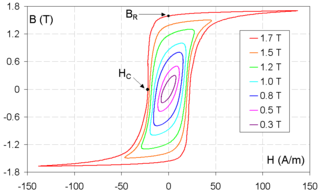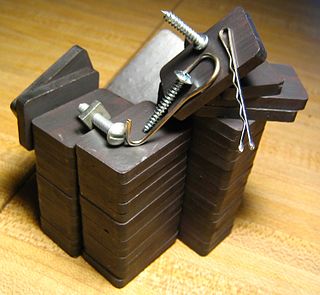Related Research Articles

A hard disk drive (HDD), hard disk, hard drive, or fixed disk, is an electro-mechanical data storage device that stores and retrieves digital data using magnetic storage with one or more rigid rapidly rotating platters coated with magnetic material. The platters are paired with magnetic heads, usually arranged on a moving actuator arm, which read and write data to the platter surfaces. Data is accessed in a random-access manner, meaning that individual blocks of data can be stored and retrieved in any order. HDDs are a type of non-volatile storage, retaining stored data when powered off. Modern HDDs are typically in the form of a small rectangular box.

Superparamagnetism is a form of magnetism which appears in small ferromagnetic or ferrimagnetic nanoparticles. In sufficiently small nanoparticles, magnetization can randomly flip direction under the influence of temperature. The typical time between two flips is called the Néel relaxation time. In the absence of an external magnetic field, when the time used to measure the magnetization of the nanoparticles is much longer than the Néel relaxation time, their magnetization appears to be in average zero; they are said to be in the superparamagnetic state. In this state, an external magnetic field is able to magnetize the nanoparticles, similarly to a paramagnet. However, their magnetic susceptibility is much larger than that of paramagnets.

A disk read-and-write head is the small part of a disk drive which moves above the disk platter and transforms the platter's magnetic field into electric current or, vice versa, transforms electric current into magnetic field. The heads have gone through a number of changes over the years.
Magnetoresistive random-access memory (MRAM) is a type of non-volatile random-access memory which stores data in magnetic domains. Developed in the mid-1980s, proponents have argued that magnetoresistive RAM will eventually surpass competing technologies to become a dominant or even universal memory. Currently, memory technologies in use such as flash RAM and DRAM have practical advantages that have so far kept MRAM in a niche role in the market.

Coercivity, also called the magnetic coercivity, coercive field or coercive force, is a measure of the ability of a ferromagnetic material to withstand an external magnetic field without becoming demagnetized. Coercivity is usually measured in oersted or ampere/meter units and is denoted HC.
Non-volatile memory (NVM) or non-volatile storage is a type of computer memory that can retain stored information even after power is removed. In contrast, volatile memory needs constant power in order to retain data.

Magnetic storage or magnetic recording is the storage of data on a magnetized medium. Magnetic storage uses different patterns of magnetisation in a magnetizable material to store data and is a form of non-volatile memory. The information is accessed using one or more read/write heads.

Giant magnetoresistance (GMR) is a quantum mechanical magnetoresistance effect observed in multilayers composed of alternating ferromagnetic and non-magnetic conductive layers. The 2007 Nobel Prize in Physics was awarded to Albert Fert and Peter Grünberg for the discovery of GMR.
Density is a measure of the quantity of information bits that can be stored on a given length of track, area of the surface, or in a given volume of a computer storage medium. Generally, higher density is more desirable, for it allows more data to be stored in the same physical space. Density therefore has a direct relationship to storage capacity of a given medium. Density also generally affects the performance within a particular medium, as well as price.
Perpendicular recording, also known as conventional magnetic recording (CMR), is a technology for data recording on magnetic media, particularly hard disks. It was first proven advantageous in 1976 by Shun-ichi Iwasaki, then professor of the Tohoku University in Japan, and first commercially implemented in 2005. The first industry-standard demonstration showing unprecedented advantage of PMR over longitudinal magnetic recording (LMR) at nanoscale dimensions was made in 1998 at IBM Almaden Research Center in collaboration with researchers of Data Storage Systems Center (DSSC) – a National Science Foundation (NSF) Engineering Research Center (ERCs) at Carnegie Mellon University (CMU).

A ferrite is a ceramic material made by mixing and firing iron(III) oxide with one or more additional metallic elements, such as strontium, barium, manganese, nickel, and zinc. They are ferrimagnetic, meaning they are attracted by magnetic fields and can be magnetized to become permanent magnets. Unlike other ferromagnetic materials, most ferrites are not electrically conductive, making them useful in applications like magnetic cores for transformers to suppress eddy currents. Ferrites can be divided into two families based on their resistance to being demagnetized.
Exchange bias or exchange anisotropy occurs in bilayers of magnetic materials where the hard magnetization behavior of an antiferromagnetic thin film causes a shift in the soft magnetization curve of a ferromagnetic film. The exchange bias phenomenon is of tremendous utility in magnetic recording, where it is used to pin the state of the readback heads of hard disk drives at exactly their point of maximum sensitivity; hence the term "bias."

Barium ferrite, abbreviated BaFe, BaM, is the chemical compound with the formula BaFe12O19. This and related ferrite materials are components in magnetic stripe cards and loudspeaker magnets.
Patterned media is a potential future hard disk drive technology to record data in magnetic islands, as opposed to current hard disk drive technology where each bit is stored in 20–30 magnetic grains within a continuous magnetic film. The islands would be patterned from a precursor magnetic film using nanolithography. It is one of the proposed technologies to succeed perpendicular recording due to the greater storage densities it would enable. BPM was introduced by Toshiba in 2010.
Racetrack memory or domain-wall memory (DWM) is an experimental non-volatile memory device under development at IBM's Almaden Research Center by a team led by physicist Stuart Parkin. In early 2008, a 3-bit version was successfully demonstrated. If it were to be developed successfully, racetrack memory would offer storage density higher than comparable solid-state memory devices like flash memory.

James John Miles is a retired Professor of Computer Engineering in the School of Computer Science at the University of Manchester where he previously was head of the school and a member of the Nano Engineering & Storage Technology Research Group (NEST).

An exchange spring magnet is a magnetic material with high coercivity and high saturation properties derived from the exchange interaction between a hard magnetic material and a soft magnetic material, respectively.

Iron–platinum nanoparticles are 3D superlattices composed of an approximately equal atomic ratio of Fe and Pt. Under standard conditions, FePt NPs exist in the face-centered cubic phase but can change to a chemically ordered face-centered tetragonal phase as a result of thermal annealing. Currently there are many synthetic methods such as water-in-oil microemulsion, one-step thermal synthesis with metal precursors, and exchanged-coupled assembly for making FePt NPs. An important property of FePt NPs is their superparamagnetic character below 10 nanometers. The superparamagnetism of FePt NPs has made them attractive candidates to be used as MRI/CT scanning agents and a high-density recording material.
Evangelos Eleftheriou is a Greek electrical engineer. He is an IBM Fellow and was responsible for the Cloud and Computing Infrastructure department at the IBM Research – Zurich laboratory in Rüschlikon, Switzerland.

Michael L. Mallary is an engineer, physicist, inventor, and author who is noted for his contributions in the areas of magnetic recording and data storage on hard disk drives (HDD). His work has concentrated on developing and optimizing magnetic components to maximize data storage density. In particular, he is responsible to inventing the 'trailing-shield' write head used universally in modern HDDs. Mallary is a Fellow of the Institute of Electrical and Electronics Engineers and recipient of the IEEE Magnetics Society Achievement Award.
References
- ↑ Victora, R.H. (2005). "Composite media for perpendicular magnetic recording". IEEE Transactions on Magnetics. Institute of Electrical and Electronics Engineers (IEEE). 41 (2): 537–542. Bibcode:2005ITM....41..537V. doi:10.1109/tmag.2004.838075. ISSN 0018-9464. S2CID 29531529.
- ↑ D. Suess; T. Schrefl; R. Dittrich; M. Kirschner; F. Dorfbauer; G. Hrkac; J. Fidler (18 December 2004). "Exchange spring recording media for areal densities up to 10Tbit/in2". Journal of Magnetism and Magnetic Materials. 290–291: 551–554. doi:10.1016/j.jmmm.2004.11.525.
- ↑ Wang, Jian-Ping; Shen, Weikang; Bai, J. (2005). "Exchange coupled composite media for perpendicular magnetic recording". IEEE Transactions on Magnetics. Institute of Electrical and Electronics Engineers (IEEE). 41 (10): 3181–3186. Bibcode:2005ITM....41.3181W. doi:10.1109/tmag.2005.855278. ISSN 0018-9464. S2CID 16178527.
- ↑ Hauet, T.; Dobisz, E.; Florez, S.; Park, J.; Lengsfield, B.; Terris, B. D.; Hellwig, O. (2009-12-28). "Role of reversal incoherency in reducing switching field and switching field distribution of exchange coupled composite bit patterned media". Applied Physics Letters. AIP Publishing. 95 (26): 262504. Bibcode:2009ApPhL..95z2504H. doi:10.1063/1.3276911. ISSN 0003-6951.
- ↑ Ikeda, Yoshihiro; Choe, Gunn; Zhang, Kezhao; Takano, Kentaro (2009). "Switching volume change and recording performance correlation for weakly coupled exchange spring media". Journal of Applied Physics. AIP Publishing. 105 (7): 07B713. Bibcode:2009JAP...105gB713I. doi:10.1063/1.3072833. ISSN 0021-8979.
- ↑ Piramanayagam, S. N.; Chong, Tow C. (2011-10-11). Developments in Data Storage. ISBN 978-1-118-09682-6.